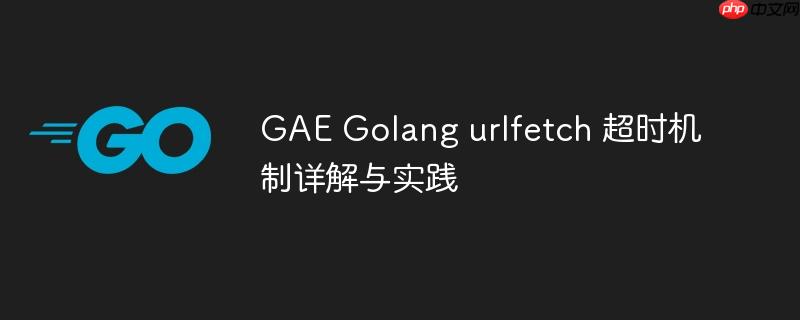
本教程详细探讨了Google app Engine (GAE) Golang环境中urlfetch服务设置超时的两种主要方法。首先,针对旧版GAE Golang,阐述了通过urlfetch.Transport的Deadline字段配置超时,并指出常见的设置误区。其次,重点介绍了新版GAE Golang中,如何利用Go标准库的context包(特别是context.WithTimeout)来优雅且高效地管理urlfetch的请求超时。文章提供了清晰的代码示例和实践建议,旨在帮助开发者正确配置和处理urlfetch的超时行为。
引言:理解 GAE Golang urlfetch 超时机制
在google app engine (gae) 的golang环境中,urlfetch服务是进行外部http请求的关键组件。然而,开发者在使用urlfetch时,常会遇到一个普遍问题:即使明确设置了较长的超时时间,请求仍可能在约5秒后自动中断。这通常是由于对urlfetch超时配置方式的误解或gae平台版本更新导致的行为差异。本教程将深入解析不同时期gae golang中urlfetch超时设置的正确姿势,并提供相应的代码示例。
旧版 GAE Golang 中的 urlfetch 超时设置 (2016年1月前)
在较早版本的GAE Golang SDK中,urlfetch的超时时间是通过urlfetch.Transport结构体的Deadline字段来配置的。开发者通常会尝试直接将一个time.Duration类型的变量赋值给Deadline。然而,正如问题描述中所示,这种直接赋值有时并不能生效,请求仍会默认在约5秒后超时。
常见问题代码示例:
package main import ( "encoding/json" "io/ioutil" "net/http" "strings" "time" "google.golang.org/appengine" "google.golang.org/appengine/urlfetch" ) // 假设 TimeoutDuration 已经被定义为 time.Duration 类型 var TimeoutDuration time.Duration = time.Second * 30 func CallLegacy(c appengine.Context, address string, allowInvalidServerCertificate bool, method string, id interface{}, params []interface{}) (map[string]interface{}, error) { data, err := json.Marshal(map[string]interface{}{ "method": method, "id": id, "params": params, }) if err != nil { return nil, err } req, err := http.NewRequest("POST", address, strings.NewReader(string(data))) if err != nil { return nil, err } // 问题代码:TimeoutDuration 变量赋值给 Deadline tr := &urlfetch.Transport{Context: c, Deadline: TimeoutDuration, AllowInvalidServerCertificate: allowInvalidServerCertificate} resp, err := tr.RoundTrip(req) if err != nil { return nil, err } defer resp.Body.Close() body, err := ioutil.ReadAll(resp.Body) if err != nil { return nil, err } result := make(map[string]interface{}) err = json.Unmarshal(body, &result) if err != nil { return nil, err } return result, nil }
尽管TimeoutDuration的类型是time.Duration,但在某些旧版SDK或特定上下文中,直接使用变量可能无法正确设置超时。
旧版 GAE Golang 正确的超时设置方法:
立即学习“go语言免费学习笔记(深入)”;
为确保Deadline字段被正确解析和应用,建议直接使用time.Duration字面量或进行明确的类型转换。
package main import ( "encoding/json" "io/ioutil" "net/http" "strings" "time" "google.golang.org/appengine" "google.golang.org/appengine/urlfetch" ) func CallLegacyCorrect(c appengine.Context, address string, allowInvalidServerCertificate bool, method string, id interface{}, params []interface{}) (map[string]interface{}, error) { data, err := json.Marshal(map[string]interface{}{ "method": method, "id": id, "params": params, }) if err != nil { return nil, err } req, err := http.NewRequest("POST", address, strings.NewReader(string(data))) if err != nil { return nil, err } // 正确设置 Deadline 的方式:直接使用 time.Duration 字面量 // 或者明确的类型转换:Deadline: time.Duration(30) * time.Second tr := &urlfetch.Transport{Context: c, Deadline: 30 * time.Second, AllowInvalidServerCertificate: allowInvalidServerCertificate} resp, err := tr.RoundTrip(req) if err != nil { return nil, err } defer resp.Body.Close() body, err := ioutil.ReadAll(resp.Body) if err != nil { return nil, err } result := make(map[string]interface{}) err = json.Unmarshal(body, &result) if err != nil { return nil, err } return result, nil }
通过将Deadline直接设置为30 * time.Second,可以确保urlfetch正确识别并应用所需的超时时间。
新版 GAE Golang 中的 urlfetch 超时设置 (2016年1月后)
自2016年1月2日起,随着GAE Golang包的更新(google.golang.org/appengine/*),urlfetch的超时管理机制发生了重大变化。urlfetch.Transport不再直接通过Deadline字段接收超时时间。取而代之的是,超时现在通过Go标准库的context包进行管理,这与Go语言的现代并发模式保持一致。
新版 GAE Golang 正确的超时设置方法:
使用context.WithTimeout函数来创建一个带有截止时间的新context,然后将这个带有超时的context传递给urlfetch.Transport。
package main import ( "context" // 导入 context 包 "encoding/json" "io/ioutil" "net/http" "strings" "time" "google.golang.org/appengine/urlfetch" // 注意:新版 GAE Golang 包通常直接使用 context.Context,而不是 appengine.Context // 如果仍需兼容旧版 appengine.Context,可使用 appengine.WithContext ) func CallModern(ctx context.Context, address string, allowInvalidServerCertificate bool, method string, id interface{}, params []interface{}) (map[string]interface{}, error) { data, err := json.Marshal(map[string]interface{}{ "method": method, "id": id, "params": params, }) if err != nil { return nil, err } req, err := http.NewRequest("POST", address, strings.NewReader(string(data))) if err != nil { return nil, err } // 1. 使用 context.WithTimeout 创建一个带超时的 context // 这里设置超时为1分钟 ctxWithDeadline, cancel := context.WithTimeout(ctx, 1*time.Minute) defer cancel() // 确保在操作结束后取消 context,释放资源 // 2. 将带有超时的 context 传递给 urlfetch.Transport // 注意:在实际应用中,urlfetch.Transport 常常作为 http.Client 的 Transport 使用 client := &http.Client{ Transport: &urlfetch.Transport{Context: ctxWithDeadline}, // 如果需要 OAuth2 认证,可以嵌套 oauth2.Transport // Transport: &oauth2.Transport{ // Base: &urlfetch.Transport{Context: ctxWithDeadline}, // }, } resp, err := client.Do(req) // 使用 http.Client 发送请求 if err != nil { return nil, err } defer resp.Body.Close() body, err := ioutil.ReadAll(resp.Body) if err != nil { return nil, err } result := make(map[string]interface{}) err = json.Unmarshal(body, &result) if err != nil { return nil, err } return result, nil }
在新版GAE Golang中,context.WithTimeout返回一个新的context和一个cancel函数。cancel函数应该在不再需要该context时调用,以释放相关资源。通常,这通过defer cancel()实现。这个新的context随后被传递给urlfetch.Transport,从而控制整个HTTP请求的超时行为。
注意事项与最佳实践
- 版本兼容性: 始终根据您项目所使用的GAE Golang SDK版本来选择正确的超时设置方法。对于新项目,强烈建议采用基于context的方法。
- 明确设置超时: 避免依赖默认的5秒超时。对于任何可能耗时的外部请求,都应明确设置一个合理的超时时间,以防止请求长时间阻塞或资源耗尽。
- 错误处理: 当使用context.WithTimeout时,如果请求因为超时而被取消,client.Do(req)可能会返回一个错误,其中包含context.DeadlineExceeded或context.Canceled。务必在代码中捕获并处理这些错误。
- 超时时长考量: 合理设置超时时长至关重要。过短的超时可能导致正常请求失败,过长的超时则可能造成资源浪费和用户体验下降。应根据目标服务的响应时间、网络延迟以及业务需求综合考虑。
- defer cancel()的重要性: 在使用context.WithTimeout或context.WithCancel时,切记调用defer cancel()。这可以确保即使函数提前返回,相关的context资源也能被及时清理,避免内存泄漏。
- http.Client的使用: 在新版GAE Golang中,urlfetch.Transport通常作为http.Client的Transport字段来使用。http.Client提供了更灵活的HTTP请求管理能力,例如重定向策略、Cookie管理等。
总结
urlfetch在GAE Golang中进行外部HTTP请求时,正确配置超时是确保应用健壮性和响应性的关键。无论是面对旧版SDK中Deadline字段的细微差别,还是拥抱新版SDK中基于context的现代化超时管理方式,理解并应用正确的实践都至关重要。通过本文的指导和示例代码,开发者应能有效地管理urlfetch的超时行为,从而构建更加稳定和高效的GAE应用程序。
js json go cookie golang go语言 app ai win google 常见问题 标准库 golang Cookie 结构体 Go语言 类型转换 并发 http


